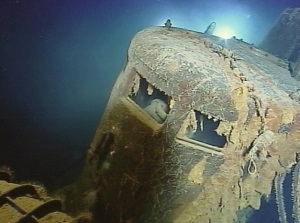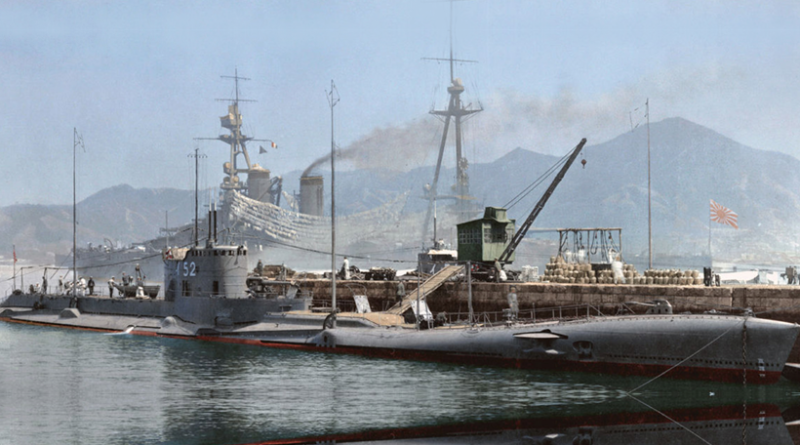In search of the mysterious Japanese golden submarine
During the Cold War, advanced deep-water detection was almost an exclusively military preserve. That began to change in the early 1990s, when Paul R. Tidwell, a maritime researcher, used once highly secret military methods and gear to locate a mysterious Japanese submarine lost in the Atlantic during World War II. In early 1995, Tidwell found the wreck of the Imperial Japanese Navy I-52, about three miles deep. It was an unusual vessel, not least because its final resting place in the Atlantic was thousands of miles away from Japan’s area of operations in Asia and the Pacific. The I-52 was also one of the biggest submarines of WWII. Even more significantly, when it sank, it was carrying more than two tons of gold, valued at about $95 million (USD) in 2019.
The discovery of the I-52 in over 17,000 feet of water on May 2, 1995, was the culmination of a five-year research effort by Tidwell. He spent years researching archives of American, British, German, and Japanese origin. As a result of his research Mr. Tidwell became convinced that the I-52 was findable.




The I-52 was a cargo carrying submarine enroute from the Kure Naval Yard in Japan to German occupied France. This specially designed submarine was to play a very important role in the commerce of strategic materials and technologies between the Axis nations. The Allied intelligence network intercepted and decoded messages revealing that the I-52 was carrying two tons of gold to purchase German optical technologies. In response, a carrier task force was dispatched from Norfolk with orders to engage and sink the I-52.
Germany and Japan, while formally allies in WWII, were more like co-combatants who happened to be fighting separate wars against some of the same opponents at the same time. Japan was desperate for German technology, while Germany was desperate for raw materials, but Allied control of the waters in between eliminated bulk exchanges via surface transports. During WWI, while America was still neutral and selling goods and armaments to both sides, the Germans had partially gotten around the Entente’s dominance of the Atlantic by sending cargo submarines to the US. There, they were laden with rare and high value goods, before returning to Germany.

During WWII, the Japanese took a page from Germany’s WWI playbook, and built large, cargo-carrying submarines. These submarines were among the largest ever built to date, and among the most advanced underwater vessels of the war. Measuring over 350 feet in length and over 30 feet in the beam, the Type C3s had a cruising range of over 20,000 nautical miles. That made them well suited for long distance trade and intelligence missions between Germany and Japan. The Japanese had initially planned to build twenty of these underwater behemoths, but as things turned out, they ended up building only three, with the I-52 being the first of the trio to enter operational service. Throughout the entire war, the Type C3s only carried out six long distance missions known as Yanagi (“exchange”) between the Axis partners. Of the three cargo submarines, two were lost in action during the conflict, and only one survived the war.
The I-52 was laid down in March of 1942 and was commissioned in December of 1943. Code named Momi, or “fir tree”, she became more popularly known as the Golden Submarine because of her cargo when she went down. Measuring 356 feet long by 31 feet wide, the I-52 was powered by two electric diesel motors that gave her a 17.7 knot speed while surfaced and allowed her to do 6.5 knots underwater on battery power. She had a cruising range of 21,000 nautical miles at 16 knots, and was depth tested for 328 feet. Her armament included six torpedo tubes, two 140 mm naval guns, and a pair of 25 mm antiaircraft guns. However, fighting was not her primary mission: she was built to carry cargo, of which she could fit 300 tons in her hold.
On March 10th, 1944, the I-52 left Kure naval base in Japan on her maiden mission. Captained by Commander Uno Kameo and crewed by 94 officers and men, the vessel had a long journey ahead of her, most of it through hostile waters. From the Sea of Japan, she was to head to the East China then South China seas. After a stop in Singapore, the I-52 was to cross the Bay of Bengal, traverse the Indian Ocean, round the Cape of Good Hope and enter the Atlantic. Then she would traverse most of the length of that ocean, before finally entering the Bay of Biscay and docking in the Nazi-controlled French port of Lorient. Her estimated date of arrival was June 6, 1944.
In her cargo hold, the I-52 carried 11 tons of tungsten, almost 10 tons of molybdenum, 3 tons of opium, and 54 kilograms of pure caffeine. She also carried 146 bars of gold, weighing 2.2 tons, intended as payment for German optical technology. In Singapore, she also picked up 3.3 tons of quinine, 60 tons of raw rubber, and 120 tons of tin. She also carried 14 passengers, mostly Japanese technicians, sent to study advanced German torpedo boat engine and antiaircraft gun technologies.
Unbeknownst to either the Germans or Japanese, Allied code breakers had cracked both the Axis partners’ secret communications. They did that so thoroughly that the Allies were often able to intercept, decode, and read Axis secret messages as fast as, or even faster than, their intended recipients. As a result, American intelligence had been decoding the I-52’s traffic signals ever since she had left Kure and was able to track her throughout her long voyage. On June 6, 1944, the Japanese naval attaché in Berlin signalled the submarine that the Allies had landed in France and advised her to make plans to head for German-occupied Norway, instead. En route, she was to meet up with a German submarine, the U-530, on June 22. The I-52 acknowledged receipt of the message, fatally including her position in the reply.
On the night of June 23, 1944, the I-52 rendezvoused as planned with the German U-530 in the mid-Atlantic. Later on, that night, torpedo carrying planes from the USS Bogue engaged the I-52 in a deadly game of cat and mouse. Although the U-boat escaped, the I-52 with her precious cargo of gold would not be seen again.
Half a century later, Paul Tidwell found her remains in a debris field three miles beneath the Atlantic, resting mostly upright, with her conning tower and hull number still visible. Plans to raise the I-52 were objected to by the Japanese government, which considered the wreck site a grave. Tidwell eventually worked out an agreement with the Japanese government, allowing him to recover the submarine’s cargo, put it on display, then return all artifacts – except the gold – to Japan. In the end, however, the recovery efforts only managed to locate a single box of opium, but no gold.
